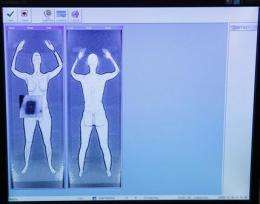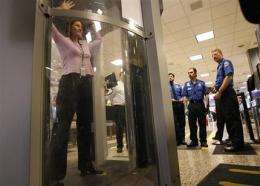Airline attack could lead to more scanners

(AP) -- The Christmas Day attack on a jetliner over Detroit, combined with technological improvements to protect people's sense of modesty, could lead to dramatically wider use of full-body scanners that can see through travelers' clothing.
Dutch officials said Wednesday they will immediately begin using the machines at Amsterdam's airport, where the Nigerian accused of trying to blow up the Northwest Airlines plane began his flight.
And a key European lawmaker also called for greater use of the scanners, which are designed to spot explosives and other non-metallic objects that a metal detector would miss.
In the U.S., the Transportation Security Administration has not said whether it will accelerate its plans to roll out the machines. TSA already operates 40 of them in U.S. airports, has bought an additional 150 and plans to buy 300 more.
That covers only a small slice of the 2,100 security lanes at the nation's 450 airports. But TSA could find the climate more favorable for an expansion.
At least one congressman who has pushed for restrictions on full-body scanners said he would moderate his stance if the technology could better respect privacy. According to several companies that make full-body scanners, software - rather than human screeners - eventually could be capable of detecting suspicious objects on travelers' bodies as they pass through the machines.
"This is a solution everyone can live with," said Rep. Jason Chaffetz, R-Utah, who sponsored a measure that would prohibit the use of whole-body imaging for "primary" screening, in place of metal detectors. The House approved the measure 310-118, and it is pending in the Senate. "The goal should be to be more effective, but less invasive."
Body scanners that peer through clothing have been available for years, but their introduction has been slowed by objections from privacy advocates such as the American Civil Liberties Union, which has denounced the machines as a "virtual strip search" because they display the body's contours on a computer screen with great clarity.
Umar Farouk Abdulmutallab, the passenger who authorities say concealed explosives in his underwear and tried to ignite them as his plane was coming in for a landing in Detroit, did not go through such a scan at Amsterdam's Schiphol airport. The European Parliament voted last year against using such machines.
New software, however, can protect travelers' privacy by producing a stylized image of the body instead of a more detailed picture.
In announcing the government's change in policy, Dutch Interior Minister Guusje Ter Horst said full-body scanners probably would have spotted the explosives on Abdulmutallab.
"Our view now is that the use of millimeter wave scanners would certainly have helped detect that he had something on his body, but you can never give 100 percent guarantees," she said.
Fifteen full-body scanners with privacy-protecting software will be used at the Amsterdam airport to screen passengers boarding flights to the U.S., authorities said.
The 15 scanners will not be enough to handle all such passengers, so some people will need to be patted down. Schiphol is waiting for a government directive on whether to buy more machines, airport spokeswoman Kathelijn Vermeulen said. Full-body scanners can cost between $130,000 and $200,000.
The broader European opposition to such decisions seemed to be fading Wednesday as Peter van Dalen, vice chairman of the European Parliament's transport committee, said a demonstration of the newer technology showed the scanners do not violate travelers' privacy. He urged the installation of the equipment across the 27-nation bloc.
TSA wouldn't comment on whether it plans to adopt something like the software that Amsterdam officials praised.
However, some manufacturers, including Rapiscan Systems and L-3 Communications Holdings Inc., already offer privacy enhancements such as blurred faces or bodily images that look like chalk outlines. TSA just bought 150 machines from Rapiscan, and L-3 makes scanners used in Amsterdam and the U.S.
Under TSA rules in effect in the U.S., images produced by full-body scans are viewed in a location not visible to the public. The security officer assisting the passenger cannot view the image and the officer who sees the image never sees the passenger.
With such measures in place, TSA has been running 40 full-body scanners at 19 U.S. airports with apparently few complaints from the public. Most of the machines are used for secondary screenings of passengers after they pass through a metal detector. But at checkpoints in six airports, they are being used instead of metal detectors: Albuquerque, N.M.; Las Vegas; Miami; San Francisco; Salt Lake City; and Tulsa, Okla.
In Salt Lake, fewer than 1 percent of passengers who were in a security line with the scanner have opted out and asked for a pat-down search instead, according to Dwayne Baird, a TSA spokesman.
In fact, around the country, many passengers have no objections to the machines and consider them less intrusive than a pat-down.
"I'd rather be safe than be embarrassed," said George Hyde of Birmingham, Ala., who was flying out of Salt Lake with his wife on Wednesday. "We're very modest people, but we'd be willing to go through that for security."
"Anything to avoid a bomb - anything," said Ellen Massar, said at the Miami airport after arriving from Amsterdam. "If they would ask me to undress totally" - and other passengers had to do so as well - "I would do it."
Her husband, Willem Massar, added: "It's the world we live in. Hopefully it gets better."

Questions and answers about full-body scanners
Travelers still getting used to removing their shoes in public and pouring shampoo into tiny bottles may soon have to adjust to something new in the airport security line - giant machines that that scan their bodies for anything a terrorist might use to cause harm during a flight.
High-tech, full-body scanning machines are already in use at a handful of airports, but they may become more common as security officials around the world respond to the attempted attack on an airliner on Christmas Day. The Netherlands announced Wednesday that the scanners would be used for all flights heading from Amsterdam's airport to the United States, and an official in Nigeria later said that country planned to buy full-body scanners too.
What exactly are these machines, and how do they work? What are the drawbacks to using these types of scans?
Here are some questions and answers about the devices.
---
Q: How do these full-body scanners work?
A: The two main types of scanners are "millimeter wave" and "backscatter" machines. Millimeter wave units send radio waves over a person and produce a three-dimensional image by measuring the energy reflected back. Backscatter machines use low-level X-rays to create a two-dimensional image of the body.
---
Q: What sorts of things can they find?
A: The machines are designed to uncover what a physical pat-down could turn up but a metal detector wouldn't find. That includes plastic or chemical explosives and nonmetallic weapons in a pocket or strapped to someone's body.
The machines would also find guns, knives and other metallic objects that would set off a metal detector.
---
Q: What can they not find?
A: Generally, the machines can't find items stashed in a body cavity. So the scanners wouldn't stop at least one common smuggling method used by drug traffickers.
---
Q: How common are they at airports?
A: Because of fears that the scans infringe on travelers' dignity by revealing bodily contours, European officials have generally limited the machines to tests in airports or train stations.
In U.S. airports, the Transportation Security Administration has begun expanding the use of full-body scanning machines, although passengers can opt for a physical pat-down instead. The TSA has 40 in place, just bought 150 and plans to buy 300 more.
Six of the machines are being used instead of a metal detector at airports in Albuquerque, N.M.; Las Vegas; Miami; San Francisco; Salt Lake City; and Tulsa, Okla. The other 34 are used for secondary screening of people who set off a metal detector in Atlanta; Dallas/Fort Worth; Denver; Detroit; Indianapolis; Jacksonville and Tampa, Fla.; Los Angeles; Phoenix; Raleigh-Durham, N.C.; Richmond, Va.; and two airports in the Washington area: Baltimore/Washington and Reagan National.
---
Q: Is there a way to make the scans less revealing?
A: The technology has evolved to reduce the clarity of identifying details. The systems blur faces, or they produce body images that look like chalk outlines.
Amsterdam's airport is moving ahead with full-body scanners after trying new software that projects a stylized image - rather than an actual picture - onto a computer screen. It highlights the area of the body where objects are concealed in pockets or under the clothing.
The TSA says it uses logistical methods to safeguard privacy. Full-body images are viewed in a walled-off location not visible to the public. The security officer assisting the passenger cannot view the image, and the officer who views the image doesn't see the passenger. If the officer viewing the image sees something of concern, he notifies the agent who is with the passenger to do further screening.
The machines can't store or print images, and the TSA says officers who view the images are not allowed to take cameras or cell phones into the screening rooms.
---
Q: How long does it take to be scanned?
A: The machines are getting faster but still can take up to 15 seconds to scan a traveler, which could make the process slower than using metal detectors.
TSA officials note that in some instances, these machines can be faster. For instance, people with medical devices that typically set off metal detectors wouldn't have to make multiple passes through the machine or be pulled aside for additional screening.
---
Q: Do security officials hope to use the full-body scanners on every person getting on a flight?
A: At the moment, that's probably not realistic - in the U.S. alone, there are 730 checkpoints with 2,100 security lanes at the nation's 450 airports, and there are thousands more lanes at airports around the world. Cost may be an issue - the machines can be $130,000 to $200,000 each.
Taking Amsterdam, where the machines are already in place, as an example: The airport's 15 scanners won't be enough to screen every U.S.-bound passenger, so pat-down searches will still be used. It remains to be seen whether that strategy will be copied at other airports.
---
Q: Do the scanners pose health risks, especially for frequent travelers?
A: The TSA says the technology is harmless.
Millimeter wave energy is common in the world, and the TSA says the scanners produce far less energy than a cell phone. The X-rays in backscatter machines are weak; TSA says the radiation is equivalent to what a person gets in two minutes of flying on an airplane.
If someone fears the technology, the TSA offers a physical pat-down.
On the Net: TSA page on body scanners: http://bit.ly/4j9hcH
©2009 The Associated Press. All rights reserved. This material may not be published, broadcast, rewritten or redistributed.

















